
There is a window that all cleaners dread. It’s beautiful and stylish and has been around for hundreds of years. Window cleaners are often struck with fear whenever they run into truly divided lights. True divided are also called French panes sometimes referred to as muntins. Windows with true divided lights make use of thin muntins between individual panes of glass. This window grid configuration is sometimes similar to the familiar tick-tack-toe pattern. This division of glass makes it time-consuming to clean because you’re cleaning in small chunks rather than the normal large squeegee strokes.
True divided light windows are a popular choice among homeowners for a few reasons. The historic aesthetic is the primary reason homeowners choose this type of window, but it’s not always based on the look. True divided light windows placed about standard windows can allow minimal light to enter a room. Many true divided light windows have insulated glass or Low-E glazing. That’s one of their greatest benefits.
Just like every other aspect of life, as technology expands, so does the improvement of windows. Simulated divided light windows have the same aesthetic look as true divided lights, but the grid is removable. Simulated divided light windows have just one piece of glass with removable muntins attached to both the interior and exterior of the glass, usually with a strong adhesive called VBH tape. Because the grilles are removable, simulated divided-light windows are extremely easy to clean.

Cleaning simulated divided lights is no different than cleaning a normal window. Once the grids are removed the normal window cleaning process will do. There is sometimes, however, an issue with removing the grids. If the windows are older or haven’t been cleaned in a long time the grids can become fragile and could break. Cleaning simulated divided lights with the grid in place can be tricky as well. Water and soap could cause the adhesive to weaken.
Many Window Genie owners prefer using a water-fed pole to clean both simulated and true divided lights. The water-fed pole system uses purified water that eliminates all the minerals and chemicals that will leave streaks on your glass. Water purity is measured in PPM (parts per million) and handheld TDS or PPM meters used to measure the purity of water are readily available for any window cleaner. Even the softest water will need to be purified using a two-part system. The initial process uses reverse osmosis. RO systems consist of a series of filters that remove sediment and other impurities. While RO water will be mostly pure to get a nice clean window, the water must go through deionization. The extra filter is filled with a special resin that will remove any impurities left in the water. The purified water is now ready to make your windows sparkle.
